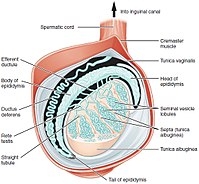
Photo from wikipedia
BackgroundCryptorchidism, the most common male genital abnormality observed in paediatrics, might often be associated with long-term functional consequences and can even reoccur after a successful orchidopexy. Serum markers that identify… Click to show full abstract
BackgroundCryptorchidism, the most common male genital abnormality observed in paediatrics, might often be associated with long-term functional consequences and can even reoccur after a successful orchidopexy. Serum markers that identify cryptorchid boys with gonadal dysfunction early should be useful in a decision-making process. Inhibin B, produced during all of childhood but altered in cryptorchid subjects, appears strictly related to Sertoli cells, and its levels directly reflect the status of the testis germinative epithelium. Unfortunately, its precise roles in bilateral and unilateral cryptorchidism are still debated and being unravelled. Herein, we report the most current knowledge about inhibin B in both healthy boys and those with cryptorchidism to discuss and clarify its potential clinical applications.DiscussionInhibin B represents a simple and repeatable serum marker and it seems to well asses the presence and function of the testicular tissue. Testicular tissue in prepubertal age is largely made up of Sertoli cells; inhibin B, coming from working Sertoli cells, allows to indirectly evaluate their function. Besides, inhibin B is produced throughout childhood, even before puberty, in contrast with central hormones, and it is not influenced by androgens during puberty, in contrast with other testicular hormones. Although further studies are needed, low levels of inhibin B have been related with low testicular score and/or with consistent alterations of testicular parameters at histological examination. This means that inhibin B could be an indirect marker of testicular functions that could even replace testicular biopsies, but current data are inconsistent to confirm this potential role of inhibin B in cryptorchidism.ConclusionInhibin B represents an effective candidate for early identification of testicular dysfunction after orchidopexy for cryptorchidism. Unfortunately, current data cannot exactly clarify the real role of inhibin B as a predictor of future testicular function in cryptorchidism and future long-term follow-up studies, with repeated inhibin B checks both in cryptorchid and in formerly cryptorchid children and adolescents, will permit to assess if previous normal levels of inhibin B would match with future normal pubertal development and fertility potential.
Journal Title: Italian Journal of Pediatrics
Year Published: 2018
Link to full text (if available)
Share on Social Media: Sign Up to like & get
recommendations!